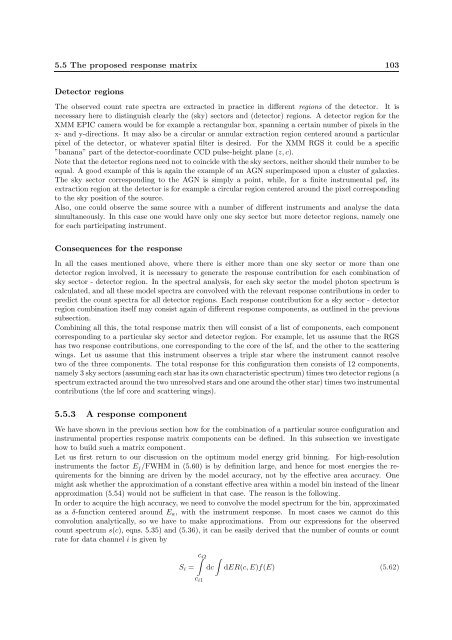SPEX User's Manual - SRON
SPEX User's Manual - SRON
SPEX User's Manual - SRON
You also want an ePaper? Increase the reach of your titles
YUMPU automatically turns print PDFs into web optimized ePapers that Google loves.
5.5 The proposed response matrix 103<br />
Detector regions<br />
The observed count rate spectra are extracted in practice in different regions of the detector. It is<br />
necessary here to distinguish clearly the (sky) sectors and (detector) regions. A detector region for the<br />
XMM EPIC camera would be for example a rectangular box, spanning a certain number of pixels in the<br />
x- and y-directions. It may also be a circular or annular extraction region centered around a particular<br />
pixel of the detector, or whatever spatial filter is desired. For the XMM RGS it could be a specific<br />
”banana” part of the detector-coordinate CCD pulse-height plane (z, c).<br />
Note that the detector regions need not to coincide with the sky sectors, neither should their number to be<br />
equal. A good example of this is again the example of an AGN superimposed upon a cluster of galaxies.<br />
The sky sector corresponding to the AGN is simply a point, while, for a finite instrumental psf, its<br />
extraction region at the detector is for example a circular region centered around the pixel corresponding<br />
to the sky position of the source.<br />
Also, one could observe the same source with a number of different instruments and analyse the data<br />
simultaneously. In this case one would have only one sky sector but more detector regions, namely one<br />
for each participating instrument.<br />
Consequences for the response<br />
In all the cases mentioned above, where there is either more than one sky sector or more than one<br />
detector region involved, it is necessary to generate the response contribution for each combination of<br />
sky sector - detector region. In the spectral analysis, for each sky sector the model photon spectrum is<br />
calculated, and all these model spectra are convolved with the relevant response contributions in order to<br />
predict the count spectra for all detector regions. Each response contribution for a sky sector - detector<br />
region combination itself may consist again of different response components, as outlined in the previous<br />
subsection.<br />
Combining all this, the total response matrix then will consist of a list of components, each component<br />
corresponding to a particular sky sector and detector region. For example, let us assume that the RGS<br />
has two response contributions, one corresponding to the core of the lsf, and the other to the scattering<br />
wings. Let us assume that this instrument observes a triple star where the instrument cannot resolve<br />
two of the three components. The total response for this configuration then consists of 12 components,<br />
namely 3 sky sectors (assuming each star has its own characteristic spectrum) times two detector regions (a<br />
spectrum extracted around the two unresolved stars and one around the other star) times two instrumental<br />
contributions (the lsf core and scattering wings).<br />
5.5.3 A response component<br />
We have shown in the previous section how for the combination of a particular source configuration and<br />
instrumental properties response matrix components can be defined. In this subsection we investigate<br />
how to build such a matrix component.<br />
Let us first return to our discussion on the optimum model energy grid binning. For high-resolution<br />
instruments the factor E j /FWHM in (5.60) is by definition large, and hence for most energies the requirements<br />
for the binning are driven by the model accuracy, not by the effective area accuracy. One<br />
might ask whether the approximation of a constant effective area within a model bin instead of the linear<br />
approximation (5.54) would not be sufficient in that case. The reason is the following.<br />
In order to acquire the high accuracy, we need to convolve the model spectrum for the bin, approximated<br />
as a δ-function centered around E a , with the instrument response. In most cases we cannot do this<br />
convolution analytically, so we have to make approximations. From our expressions for the observed<br />
count spectrum s(c), eqns. 5.35) and (5.36), it can be easily derived that the number of counts or count<br />
rate for data channel i is given by<br />
∫c i2 ∫<br />
S i = dc<br />
c i1<br />
dER(c, E)f(E) (5.62)

















